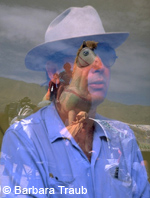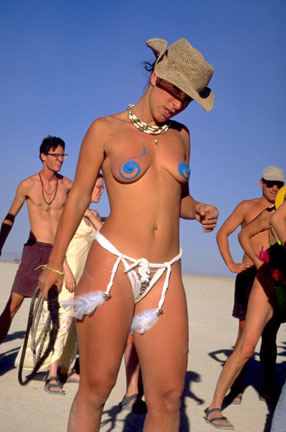 |
→ July 2007 Contents → Feature
|
Out There:
Burning Man July 2007
|
 |
|
Imagine a completely abstract space, a world without context, a place that is no place at all apart from what you bring to it. Anyone may enter this arena. Distinctions of race, class, age and wealth are irrelevant here. Participants are free to reinvent their own identities. Reality is what you make it on this ultimate frontier. It is a world wherein the boundary that divides the inner from the outer disappears.
The place is Northern Nevada's Black Rock Desert, the largest flat expanse of land in North America. The event is "Burning Man." Since 1990 members of the Burning Man Project have crafted a 4-story tall wooden man and installed it in the vastness of this awesome space. Erected by participants, it presides over an instantaneous community – a miniature civilization complete with clubs and cabarets, several radio stations, and a daily newspaper, The Black Rock Gazette. The masthead motto of this journal sets the tone of the ensuing weekend: "Welcome to Nowhere," it reads. "Its name is whatever you name it. Its wealth is whatever you bring. Next week it will be gone, but next week might as well be never. You are here now."

STRUT
But this is only half the story. There remains the Burning Man. Its towering presence looms above and beyond this postmodern carnival of the absurd. Located at the end of a monumental avenue of spires, it stands swathed in an eerie blue nimbus of neon light. And there are moments, as one wanders through this nighttime world, when earth and heaven seem to merge and Burning Man becomes the only orienting landmark. Car lights veer and drift at disconcerting angles, fireworks flash overhead, and the Man becomes a beacon, the ultimate gathering place and ceremonial center of this society suspended in a void. Taller than one's parents as remembered from some dream of childhood, emphatic as a child's first scrawled drawing of a human being, he waits with perfect patience to be burned.
There is no single interpretation of this event. It is a unique product of our age: pluralistic and complex, skeptical and yet completely open-minded. Pressed to explain their intentions, organizers cite a simple doctrine: "The Project," one is told, "never interferes with anyone's immediate experience." Only by direct participation, through one's own unique involvement, can any answer be found. Or to quote Danger Ranger, legendary protector of the Playa, "In the desert there are as many paths to heaven as there are stars in the sky."
© Larry Harvey
|
|
Back to July 2007 Contents
|
|